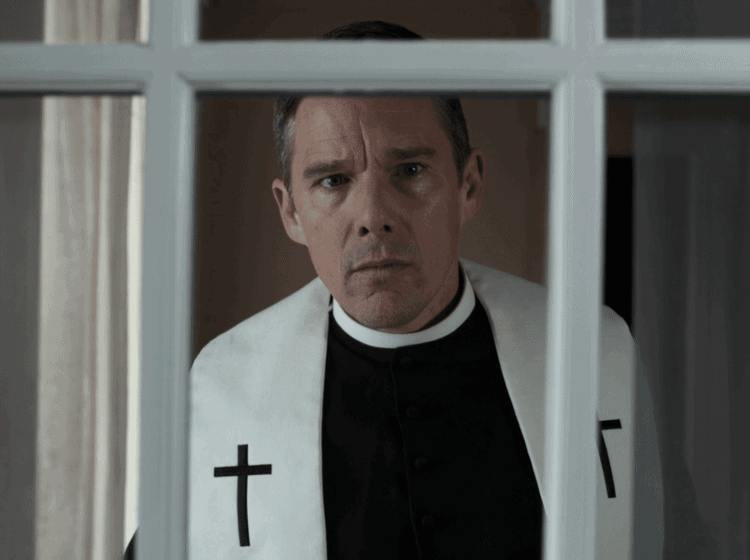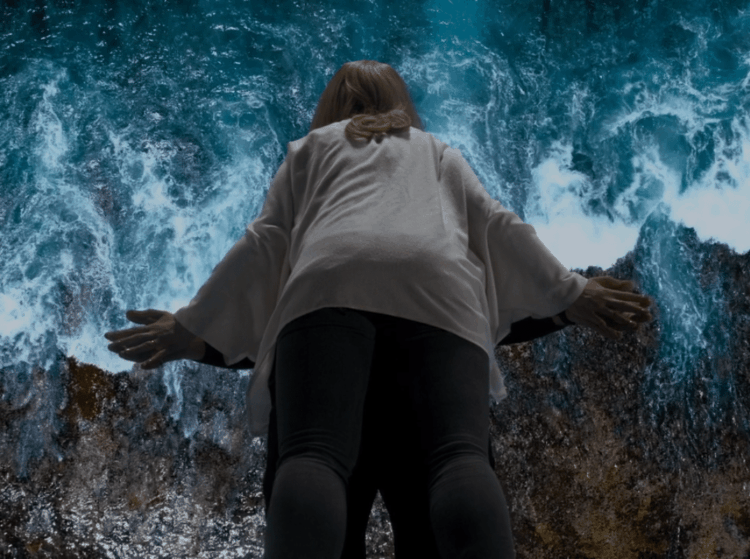Just like the transcendental movies Paul Schrader first wrote about 46 years ago, ‘First Reformed’ is shot in a restrained manner designed to open up space for the spiritual.
Like his collaborator Martin Scorsese’s Silence, Paul Schrader’s latest film is a culmination of and collision between the themes that run through his entire filmography: guilt, religion, violent revenge, and lonely, troubled men. Drawing on his own observations about the “transcendental” mode of filmmaking – a style shared by filmmaking greats like Robert Bresson, Yasujiro Ozu and Carl Theodor Dreyer that Schrader literally wrote the book on – First Reformed is shot in a restrained manner designed to open up space for the spiritual. It’s full of the hallmarks of the style of filmmaking Schrader first identified: static camerawork, empty, lingering shots and the absence of elements (like musical scores) that would fill the void intentionally created for audience meditation. As cinematically referential as it is, though, knowledge of its influences isn’t a prerequisite to viewing First Reformed, because it’s so rooted in the cardinal anxieties of our time: radicalism and climate change.
Drawing on Bresson’s Diary of a Country Priest, First Reformed processes these issues via a narration that tracks the psychological transformation of Ernst Toller (Ethan Hawke), the reverend of a barely frequented upstate New York church. Reading from diary entries, Toller delivers his narration in the dispassionate style of Country Priest’s protagonist (Claude Laydu) rather than, say, the self-indulgent tones of Bridget Jones. As a Calvinist, his lifestyle is akin to Laydu’s character’s, too: he sleeps in a single bed in a room made of hard wood, takes painful pisses in a bathroom lit by a bare bulb, and, showing great commitment to the Eucharist, lives only on a diet of bread dipped in whisky.
But the asceticism doesn’t end there; it’s consciously carried through in the film’s cinematography. Perhaps most immediately striking is Schrader’s choice of aspect ratio: a boxy 1.37:1, also known as the Academy ratio. Although it was virtually the universal standard for filmmaking at the start of the 20th century, the Academy ratio has largely been absent from our screens since the move to widescreen in the ‘50s. Most modern filmmakers still favour widescreen for the visual luxuries or enhanced sense of cinematic-ness it lends their movies, but the Academy ratio has experienced something of a revival in the last twenty years. Directors like Andrea Arnold, Wes Anderson and Paweł Pawlikowski have all opted for its limited look recently, with Pawlikowski’s spectacular-looking Ida playing a key role in inspiring Schrader’s decision to go Academy for First Reformed’s look.

For both Ida and Schrader’s movie, the result is a visual format that mimics the metaphorical smallness of their protagonists’ lives, and one that imparts a sense of claustrophobia on their viewers: with reference to the strict confines of First Reformed’s images, the camera’s height and angle often make it feel like it’s intruding, especially during close-ups and a scene set in a doctor’s office.
But where Ida uses a large margin of negative space towards the top of its square-ish shots – subtly invoking the heavenly presence that the film’s protagonist consults with – Alexander Dynan’s cinematography is more conventionally people-centric in its camera placement. That isn’t to say that First Reformed lacks visual metaphor: when the camera ventures outdoors into endangered, wintry nature, the shots are almost evenly split between land and sky, divine ceiling and earthly basement. There’s an easy heaven/hell link to be made here, although it feels more appropriate to consider these compositions as a visual rendering of what Toller comes to realize: that, like his hope and despair, there is an inextricable connection between soil and the celestial. Just as Ida rediscovers her Catholic devotion by immersing herself in the carnal, material life, for Toller, addressing the very physical ravaging of the earth becomes a religious imperative: “Will God forgive us for what we’re doing to His creation?”
In interviews, Pawlikowski has explained Ida’s aspect ratio as the natural choice given its period setting. Unlike Ida, however, First Reformed is very much set in the modern day, so Schrader’s choice of aspect ratio can’t be interpreted in the same way. Instead, its pared down look represents something of a return to basics; a rejection of the luxuries of widescreen. (Though not of technological innovation; rather than opt for the grainy, retro look of film, the movie is shot in crisp digital.) Much like Toller’s decision to keep a diary on paper rather than in digital format, First Reformed’s aspect ratio feels like a conscious reversion to cinematic primitivity, a style foreshadowed by the vintage design of its opening credits.
First Reformed‘s is a stripped down, Spartan look that reflects Toller’s essentials-only, ascetic lifestyle – which is also mirrored in the camera’s near-total lack of motion. The movie is largely made up of static shots with minimal editing, as if to pan or tilt would be an ungodly indulgence. Audiences are therefore forced to wait for a scene to begin and for it to end. In our own interview with Schrader, the director describes this as “the delayed cut”, and also explains how the movie’s aversion to splitting shots up means audiences are forced to edit scenes with their own eyes. The relative absence of the edit also tacitly references the stagnancy of Toller’s life, as the unbroken camerawork captures the natural monotony of his everyday existence in a cold, lonely environment. Schrader uses a realist approach to filmmaking in this sense, although the lack of guidance from an editor opens up the possibility for audiences to unearth something abstract – something transcendental, and therefore decidedly non-realist – in the unabridged action of a scene.
And there is, too, the effect of the cinematography on the actors to consider: deprived of the charity of an edit and forced to comply with the intimate demands of the Academy ratio, the performers are exceptionally vulnerable. With a cast of this caliber, however, there’s nothing to worry about here; to borrow one of Toller’s lines, the results of Hawke, Amanda Seyfried, Cedric Kyles, Victoria Hill and Philip Ettinger’s work are “exhilarating”.

That’s also an apt word to describe the two scenes in which the camera breaks its lethargy. Not coincidentally, the first occurs when the lonely Toller experiences a moment of great intimacy with Mary (Seyfried): the two lie face-to-face, fingers interlocked and noses touching. The camera starts to revolve around the pair before – miraculously – it lifts, scooping us up for a surreal, acrobatic sequence in which Toller surveys the beauty, the majesty, and finally the degradation of the planet. It’s a scene that shatters every unwritten convention previously established in the film, and one that fulfills the final criterion for First Reformed to qualify as one of Schrader’s transcendental films.
The other transgression is in the movie’s final scene, during which Mary’s presence distracts Toller from a fit of suicidal madness. The two embrace and kiss, and it’s as if the camera has suddenly been let off its leash: it spins around the pair like a gleeful observer before another convention of the film is abruptly broken. Where First Reformed favors a minimal editing approach for the majority of its runtime, its last moments are cut with all the zeal and ferocity of an editor who’s hands have been shackled for the preceding 100 minutes. The credits that follow aren’t silent – Lustmord’s rumbling ambient score kicks in – but they’re quiet enough to serve the audience’s immediate need to process the eccentricity of what just happened.
Making sense of the ending feels like an impossible task for a film as deliberately perplexing as First Reformed. Nevertheless, it leaves us with much more to think about – not least the relationship between its self-denying cinematography and the ascetic life of its protagonist.
The post The Visual Austerity of ‘First Reformed’ appeared first on Film School Rejects.


0 comments:
Post a Comment